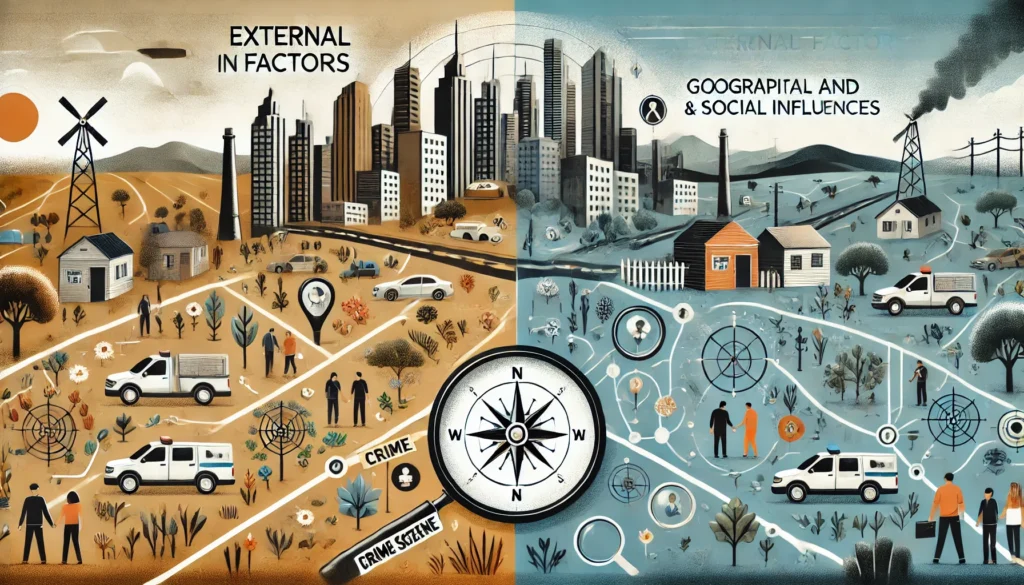Criminology, the study of crime and criminal behavior, often examines various factors that influence criminal activities. Among these, external factors such as geographical and social conditions play a significant role in shaping crime patterns and tendencies. Understanding these external influences helps criminologists and law enforcement agencies design effective strategies to prevent and address crime. This article explores the impact of geographical and social factors on criminology.
Geographical Factors in Criminology
The Role of Environment in Crime
Geographical factors refer to the physical and environmental aspects that influence criminal behavior. These include urbanization, population density, and the availability of resources. Certain areas may have higher crime rates due to specific geographical characteristics, such as:
- Urban vs. Rural Dynamics: Urban areas tend to experience higher crime rates compared to rural areas due to increased population density and anonymity.
- Proximity to High-Crime Zones: Neighborhoods adjacent to high-crime areas may experience spillover effects, resulting in increased criminal activities.
Climate and Seasonality
Climate and seasonal changes can also affect crime rates. For instance:
- Warmer climates often correlate with higher rates of violent crimes.
- Seasonal trends show increased crimes during summer months when outdoor activities and social interactions peak.
Accessibility and Infrastructure
The layout and infrastructure of a region influence criminal opportunities. Areas with:
- Poor lighting and lack of surveillance are more prone to crimes.
- Efficient transportation systems may facilitate crimes such as smuggling or trafficking.
Social Factors in Criminology
The Influence of Socioeconomic Status
Social factors encompass societal norms, economic conditions, and cultural influences. A significant social factor influencing crime is socioeconomic status. Key aspects include:
- Poverty and Unemployment: Economic deprivation often leads to increased criminal activities as individuals may resort to illegal means to fulfill basic needs.
- Education and Awareness: Lack of education can limit opportunities, pushing individuals toward crime.
Peer Influence and Social Networks
Social relationships and peer influence are crucial in shaping behavior. For example:
- Gang Membership: Gangs provide a sense of belonging but often encourage criminal activities.
- Family Dynamics: Dysfunctional family environments can increase the likelihood of criminal behavior.
Cultural Norms and Deviance
Cultural attitudes toward certain behaviors influence what is considered deviant or criminal. For example:
- Societies with lenient views on corruption may experience higher levels of white-collar crimes.
- In contrast, strict societal norms can reduce the prevalence of specific crimes.

Interplay Between Geographical and Social Factors
Geographical and social factors often interact to create unique crime patterns. For example:
- A densely populated urban area with high unemployment rates is likely to experience more theft and violent crimes.
- Conversely, rural areas with limited access to resources may see crimes related to property disputes or substance abuse.
Mitigating the Impact of External Factors on Crime
Understanding geographical and social factors enables the development of targeted crime prevention strategies. Recommendations include:
- Urban Planning: Improve lighting, surveillance, and public spaces to reduce crime opportunities.
- Community Programs: Address social issues like poverty and unemployment through education and job creation initiatives.
- Law Enforcement Collaboration: Foster partnerships between law enforcement and community organizations to address root causes of crime.
Conclusion
Geographical and social factors are integral to understanding crime dynamics. By studying these external influences, criminologists and policymakers can devise comprehensive strategies to reduce crime and promote safer communities. The interplay of these factors underscores the complexity of criminal behavior, requiring a multifaceted approach to effectively address it.

